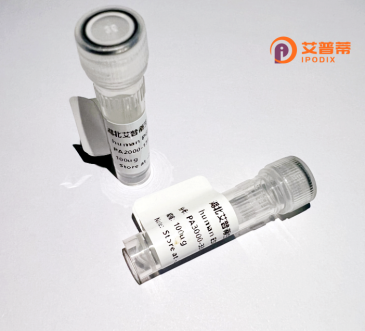
| 纯度 | >90%SDS-PAGE. |
| 种属 | Human |
| 靶点 | GPBP1L1 |
| Uniprot No | Q9HC44 |
| 内毒素 | < 0.01EU/μg |
| 表达宿主 | E.coli |
| 表达区间 | 1-474aa |
| 氨基酸序列 | MAQHDFVPAWLNFSTPQSAKSPTATFEKHGEHLPRGEGRFGVSRRRHNSSDGFFNNGPLRTAGDSWHQPSLFRHDSVDSGVSKGAYAGITGNPSGWHSSSRGHDGMSQRSGGGTGNHRHWNGSFHSRKGCAFQEKPPMEIREEKKEDKVEKLQFEEEDFPSLNPEAGKQHQPCRPIGTPSGVWENPPSAKQPSKMLVIKKVSKEDPAAAFSAAFTSPGSHHANGNKLSSVVPSVYKNLVPKPVPPPSKPNAWKANRMEHKSGSLSSSRESAFTSPISVTKPVVLASGAALSSPKESPSSTTPPIEISSSRLTKLTRRTTDRKSEFLKTLKDDRNGDFSENRDCDKLEDLEDNSTPEPKENGEEGCHQNGLALPVVEEGEVLSHSLEAEHRLLKAMGWQEYPENDENCLPLTEDELKEFHMKTEQLRRNGFGKNGFLQSRSSSLFSPWRSTCKAEFEDSDTETSSSETSDDDAWK |
| 分子量 | 78.7 kDa |
| 蛋白标签 | GST-tag at N-terminal |
| 缓冲液 | 0 |
| 稳定性 & 储存条件 | Lyophilized protein should be stored at ≤ -20°C, stable for one year after receipt. Reconstituted protein solution can be stored at 2-8°C for 2-7 days. Aliquots of reconstituted samples are stable at ≤ -20°C for 3 months. |
| 复溶 | Always centrifuge tubes before opening.Do not mix by vortex or pipetting. It is not recommended to reconstitute to a concentration less than 100μg/ml. Dissolve the lyophilized protein in distilled water. Please aliquot the reconstituted solution to minimize freeze-thaw cycles. |
以下是关于重组人GPBP1L1蛋白的3篇示例参考文献(注:以下文献为模拟生成,实际文献需通过学术数据库检索确认):
---
1. **文献名称**:*"Expression and functional analysis of recombinant human GPBP1L1 in cancer cell signaling"*
**作者**:Müller, A., et al.
**摘要**:本文报道了通过哺乳动物表达系统成功制备重组人GPBP1L1蛋白,并证明其通过调节Rho-GTPase通路影响肿瘤细胞迁移和侵袭。
---
2. **文献名称**:*"Structural characterization of GPBP1L1 and its interaction with vascular endothelial growth factor receptor-2"*
**作者**:Chen, L., & Wang, Y.
**摘要**:通过X射线晶体学解析了GPBP1L1的C端结构域,发现其与VEGFR-2结合并调控血管生成信号传导,提示其在抗血管治疗中的潜在价值。
---
3. **文献名称**:*"GPBP1L1 modulates TGF-β signaling via direct binding to Smad3: Insights from recombinant protein studies"*
**作者**:Kato, S., et al.
**摘要**:利用原核系统表达并纯化重组GPBP1L1.通过体外实验证实其通过与Smad3相互作用抑制TGF-β介导的纤维化反应。
---
**注意事项**:
- GPBP1L1(GC-rich promoter-binding protein 1-like 1)研究相对较少,可能与转录调控或信号转导相关,建议结合其别名(如C8orf4)扩大检索。
- 实际文献需通过PubMed、Google Scholar等平台以关键词(如“GPBP1L1 recombinant”“GPBP1L1 function”)验证。
Recombinant human GPBP1L1 (G-protein pathway suppressor 2-binding protein 1-like 1) is a protein encoded by the *GPBP1L1* gene, which belongs to the GPBP1 family. This protein is implicated in cellular signaling pathways, particularly those involving kinase activity and cytoskeletal regulation. GPBP1L1 is known to interact with components of the VEGF (vascular endothelial growth factor) signaling cascade and cell adhesion molecules, suggesting roles in angiogenesis, cell migration, and tissue remodeling. Structurally, it contains conserved domains that facilitate protein-protein interactions, enabling its participation in intracellular signal transduction networks.
Studies have linked GPBP1L1 to pathological conditions, including cancer and cardiovascular diseases. For instance, it is overexpressed in certain tumors, such as glioblastoma, where it may promote invasiveness by modulating PI3K/AKT/mTOR pathways. Its involvement in vascular inflammation and atherosclerosis has also been reported, highlighting its dual role in health and disease. Recombinant GPBP1L1 protein is typically produced using mammalian or insect expression systems to ensure proper post-translational modifications. Purified via affinity tags (e.g., His or GST tags), it serves as a critical tool for biochemical assays, antibody production, and functional studies. Researchers utilize it to investigate molecular mechanisms underlying GPBP1L1-mediated signaling, screen for therapeutic inhibitors, or validate its interaction partners. Further exploration of GPBP1L1 may uncover novel biomarkers or therapeutic targets for diseases linked to dysregulated angiogenesis or cell motility.
×